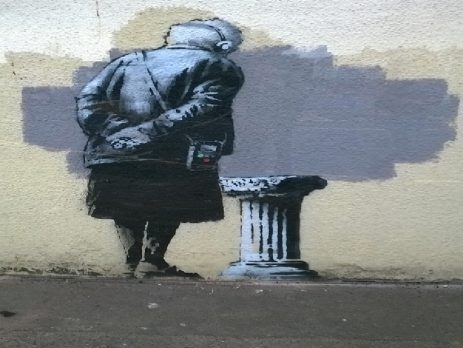Details of a 2015 case featuring a Banksy original known as the ‘Art Buff’ have recently resurfaced online following installation of the artwork in a public courtyard in Folkestone. The ‘Art Buff’, which depicts a woman gazing at an empty plinth, first appeared during the 2014 Folkestone Triennial (“the Triennial”). The Triennial is the brainchild of Creative Folkestone and is the largest exhibition of newly commissioned work presented in the UK.
Importantly though, Dreamland Leisure never sought their landlord’s permission to remove the piece of wall hosting the ‘Art Buff’. It failed to sell at auction and public/online protests demanding the return of the artwork to Folkestone began.
Creative Folkestone, who were at the time known as The Creative Foundation, began legal proceedings against Dreamland Leisure to secure the painting’s return (The Creative Foundation -v- Dreamland Leisure Limited & Others [2015] EWHC 2556 (Ch)). The claim raised two issues which were both in dispute – (1) whether it was reasonable for Dreamland Leisure to remove the Banksy artwork from the wall as tenant of the amusement arcade in order to comply with its repairing obligation; and (2) whether ownership of the artwork became vested in Dreamland Leisure once it was removed.
The Creative Foundation’s position was that the artwork became part of the land owned by the landlord when it was added to the wall of the amusement arcade. Dreamland Leisure subsequently did not have the right to treat the artwork as their own and take it away by removing the wall from the building.
Dreamland Leisure’s counter argument was that the wall was cut into in order to remove the painting so as to comply with the repairing obligation under the lease. Dreamland Leisure claimed that the part of the wall removed (and therefore the artwork) became vested in their company as the tenant. The company further countered that the chosen method of repair, being removal, was reasonable compared with alternatives such as cleaning off and painting over.
Arnold J was persuaded, albeit ‘narrowly’, that Dreamland Leisure were complying with the repairing obligation when the artwork was removed, however he did not agree that removal was reasonable.
Arnold J held that, in the absence of a direct authority dealing with the point, it was necessary to imply a term into the lease that the artwork became property of the landlord when it was cut from the wall. There were 4 clear reasons for this detailed by the Judge.
- By default, every part of a property belongs to the landlord so that the tenant has the burden of proving there is an implied term that ownership of part of the property transfers to it instead;
- Just because Dreamland Leisure discharged the repair obligation did not mean such a term was implied;
- Even if such a term was implied in relation to ownership of waste or chattels with minimal value this does not mean it is implied with regard to chattels with a substantial value (such as a Banksy painting); and
- Where a third party’s actions increase the value of the chattels, the landlord has a better right to this increase in value than the tenant.
The Creative Foundation -v- Dreamland Leisure Limited & Others is a useful precedent in an area that is somewhat lacking in case law. Whilst the case demonstrates how Banksy is not only making an impact on the street art scene, but also the landlord and tenant relationships, it is also a warning to tenants of the implications of removing high-value chattels in the process of carrying out their contractual obligations.
Share on LinkedIn



